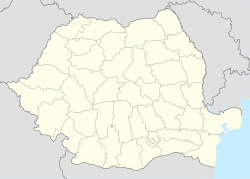Aiud
| Aiud Nagyenyed | |
|---|---|
 Pohled na Aiud | |
| Poloha | |
| Souřadnice | 46°18′35″ s. š., 23°43′27″ v. d. |
| Nadmořská výška | 260 m n. m. |
| Časové pásmo | +2 |
| Stát | |
| Župa | Alba |
| Historické území | Sedmihradsko |
| Rozloha a obyvatelstvo | |
| Rozloha | 142,52 km² |
| Počet obyvatel | 22 876 (2011) |
| Hustota zalidnění | 160,5 obyv./km² |
| Etnické složení | Rumuni (74,11 %), Maďaři (14,7 %), Romové (4,06 %) |
| Náboženské složení | křesťané (pravoslaví 72,07 %, reformovaná církev 12,06 %, řečtí katolíci 3,19 %, římští katolíci 1,29 %) |
| Správa | |
| Status | Město |
| Starostka | Oana Badea |
| Oficiální web | www |
| office | |
| PSČ | 515200 |
| Označení vozidel | AB |
| Některá data mohou pocházet z datové položky. | |
Aiud (německy Straßburg am Mieresch, maďarsky Nagyenyed) je město v Rumunsku v župě Alba. Nachází se u břehu stejnojmenné řeky Aiud (levostranný přítok řeky Mureș), asi 68 km jihovýchodně od Kluže a asi 389 km severozápadně od Bukurešti. V roce 2011 žilo ve městě 22 876 obyvatel, Aiud je tak třetím největším městem župy Alba. Ve městě žije výrazná maďarská menšina (14,7 % obyvatelstva).
První písemná zmínka o městě pochází z roku 1293. Městem prochází silnice DN1, východně od města prochází dálnice A10 (evropská silnice E81). Název Aiud vznikl odvozením od jména Aegidius (svatý Jiljí, jemuž zde byl zasvěcen první kostel). Ve městě se nachází zámek a velké množství kostelů, například ortodoxní kostel svaté Alžběty, ortodoxní kostel Povýšení svatého Kříže, reformovaný kostel, letniční kostel a kostel adventistů sedmého dne.
Odkazy
Reference
V tomto článku byl použit překlad textu z článku Aiud na anglické Wikipedii.
Externí odkazy
 Obrázky, zvuky či videa k tématu Ajud na Wikimedia Commons
Obrázky, zvuky či videa k tématu Ajud na Wikimedia Commons
Média použitá na této stránce
Autor: me, Licence: CC BY 2.5
View of Aiud from the (reformed) church's tower.
| This is a photo of a historic monument in județul Alba, classified with number AB-II-a-A-00172. |
The coat of arms of the municipality of Aiud, according to annex no. 1, consists of a cut shield, having the upper part split; in the first quarter, on the red field, there is a golden gate equipped with a cross and two medallions containing popular golden motifs; in the open space of the gate can be seen a bunch of grapes and a vine leaf, also of gold; in the second quarter, on a field azure, a silver griffin, tongued red, holding with the right claw a sword, and with the left a scale, both of the same metal. In the lower part, on a gold background, an open, natural book. The shield is stamped by a silver mural crown consisting of five crenellated towers.
The meaning of the summed elements:
- the gate reveals the value of folklore creation;
- grapes, the share that viticulture had in the past;
- the sword, the participation of the inhabitants in the defensive fight;
- the scale, the attribute of the urban administrative body;
- the open book recalls the important cultural institutions existing in this city (the Bethlen Library, established in 1662, and the Museum of Natural Sciences, in 1796).





